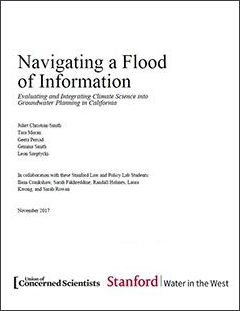In California, groundwater contributes more than half of the state’s water supply during dry years (DWR 2009). Understanding the impacts that climate change will have upon this critical resource is of importance for the state’s long-term water and food security.
This white paper intends to:
- Provide water managers and other decision makers across the state with an overview of climate models, their component parts, and key terminology
- Provide a framework for evaluating and comparing the various approaches to incorporating climate change into state-level water planning documents
- Recommend a four-step process to incorporate future climate projections into local Groundwater Sustainability Plans
Key recommendations
- State and federal agencies operating water infrastructure within the state should develop a consistent approach to incorporating climate change in their planning and guidance documents.
- Where state-provided climate projections are incomplete or inconsistent, we recommend that local agencies combine historical data with climate change projections to develop “rule of thumb” estimates of future water deliveries.
- Local groundwater agencies should stress-test their plans by adopting or constructing worst-case scenario projections and devising appropriate contingency plans in advance.
- Alternative Plans submitted to the Department of Water should include quantitative analysis of climate change that is specifically linked to the stated management objectives.
- Climate change analysis should take into account the flexibility of proposed management actions and the level of acceptable risk.




